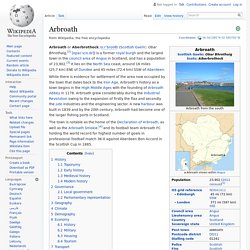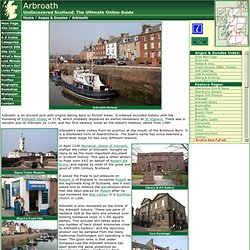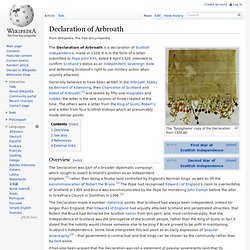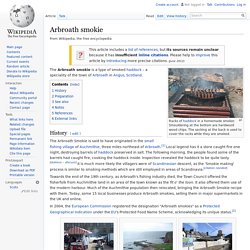

Arbroath. Coordinates: Arbroath or Aberbrothock /ɑːrˈbroʊθ/ (Scottish Gaelic: Obar Bhrothaig,[2] [opəɾˈvɾo.ɪkʲ]) is a former royal burgh and the largest town in the council area of Angus in Scotland, and has a population of 23,902.[3] It lies on the North Sea coast, around 16 miles (25.7 km) ENE of Dundee and 45 miles (72.4 km) SSW of Aberdeen.

While there is evidence for settlement of the area now occupied by the town that dates back to the Iron Age, Arbroath's history as a town begins in the High Middle Ages with the founding of Arbroath Abbey in 1178. Arbroath grew considerably during the Industrial Revolution owing to the expansion of firstly the flax and secondly the jute industries and the engineering sector. A new harbour was built in 1839 and by the 20th century, Arbroath had become one of the larger fishing ports in Scotland.
History[edit] Toponymy[edit] Early history[edit] The area around Arbroath has been occupied since at least the Neolithic period. Arbroath Feature Page on Undiscovered Scotland. Arbroath is an ancient port with origins dating back to Pictish times.

It entered recorded history with the founding of Arbroath Abbey in 1178, which probably displaced an earlier monastery at St Vigeans. There was a wooden pier at Arbroath by 1194, and the first harbour, know as the Abbot's Harbour, dated from 1394. Arbroath's name comes from its position at the mouth of the Brothock Burn: it is a shortened form of Aberbrothock. The town's name has since reached a world-wide stage for two very different reasons. Arbroath.com - all about Arbroath, its history, the attractions and its world famous Arbroath Smokies.
The Home of Arbroath, Angus, Scotland on the Internet! This site uses some unobtrusive cookies to store information on your computer.

Some cookies on this site are essential, and the site won't work as expected without them. These cookies are set when you submit a form, login or interact with the site by doing something that goes beyond clicking on simple links. We also use some non-essential cookies to anonymously track visitors or enhance your experience of the site. If you're not happy with this, we won't set these cookies but some nice features of the site may be unavailable.Some cookies on this site are essential, and the site won't work as expected without them. These cookies are set when you submit a form, login or interact with the site by doing something that goes beyond clicking on simple links. We also use some non-essential cookies to anonymously track visitors or enhance your experience of the site. To control third party cookies, you can also adjust your browser settings . (One cookie will be set to store your preference)
Activ.gif. Broughty Ferry is a pleasant suburb of Dundee with a good selection of pubs and restaurants, which are a popular haunt on summer evenings.

Four miles east of central Dundee lies the seaside settlement of Broughty Ferry, now engulfed by the city as a reluctant suburb. Comprising an eclectic mix of big villas built by jute barons up the hillside and small fishermen's cottages along the shoreline, 'The Ferry', as its known, has experienced a recent resurgence and is now a popular and relaxing spot with some good restaurants and pubs that get particularly busy on summer evenings. Arbroath. A Glimpse Of Old Arbroath. Fit Like ? - An Arbroath Timeline. The Round O - rare prints and pictures of Arbroath Abbey. Ideal Scottish gifts. Arbroath ToonFest. Arbroath Seafest. Arbroath Abbey. Arbroath Abbey, showing distinctive sandstone colouring.

Arbroath Abbey, in the Scottish town of Arbroath, was founded in 1178 by King William the Lion for a group of Tironensian Benedictine monks from Kelso Abbey. It was consecrated in 1197 with a dedication to the deceased Saint Thomas Becket, whom the king had met at the English court. It was William's only personal foundation — he was buried before the high altar of the church in 1214.
History[edit] King William gave the Abbey independence from its mother church and endowed it generously, including income from 24 parishes, land in every royal burgh and more. Arbroath Abbey. Declaration of Arbroath. The 'Tyninghame' copy of the Declaration from 1320 AD The Declaration of Arbroath is a declaration of Scottish independence, made in 1320.

It is in the form of a letter submitted to Pope John XXII, dated 6 April 1320, intended to confirm Scotland's status as an independent, sovereign state and defending Scotland's right to use military action when unjustly attacked. Declaration of Arbroath. Arbroath smokie. Racks of haddock in a homemade smoker.

Smouldering at the bottom are hardwood wood chips. Arbroath Smokies. Arbroath to Carnoustie. A one-way walk along the coast from Abroath to Carnoustie where the train (or bus) can be caught for the return.

Almost level, the path is indistinct in places and uses two level crossings over the railway. Terrain Surfaced path, rough dune and coastal path, sandy shore. Public Transport Train and bus to Abroath and Carnoustie Start Arbroath harbour car park. Users' reports As well as reading our description of each walking route, you can read about the experiences of others users on this walk and others.There are 1 user reports for this walk - click to read. Write your own report - there's £90 to win at Webtogs each month. Station facilities for Arbroath. Neil Arnott. Neil Arnott (b.

Arbroath , 15 May 1788; d. 2 March 1874 in London ) was a Scottish physician . Neil Arnott FRS was a distinguished graduate of Marischal College , University of Aberdeen (AM, 1805; MD 1814) and subsequently learned in London under Sir Everard Home (1756-1832), through whom he obtained, while yet in his nineteenth year, the appointment of full surgeon to an East Indiaman. Arnott. Sir, - Allow me to thank you for the insertion of my two former letters in your valuable journal upon the subject of these stoves.

It has been the means of obtaining for me some very useful information, which I might not otherwise have been able to have received. The stove-maker complains that I have “done him an injury by the publicity I have given to what has occurred in my house from his stove” (sold to me as one of Dr Arnott’s.) “He thinks that the whole facts and circumstances should be published by him, together with such observations as he may think necessary to make, and if he had my concurrence, he thinks it would be as well to do so with names of parties.” I have written him that I can have no possible objection to any publicity which he may think it necessary to give in his own justification; and I am satisfied that you, Sir, will afford him the opportunity, if he should think it does to his or not.
Waterbed. A waterbed , water mattress , or flotation mattress is a bed or mattress filled with water. Waterbeds intended for medical therapies appear in various reports through the 19th century. The modern version, invented in San Francisco and patented in 1971, became an extremely popular consumer item in the United States through the 1970s. Construction [ edit ] Softside Waterbed 160 × 200 cm with dual heating. David Dunbar Buick. David Dunbar Buick (September 17, 1854 – March 5, 1929) was a Scottish -born American Detroit -based inventor, best known for founding the Buick Motor Company .
He headed this company and its predecessor from 1902 until 1906, thereby helping to create one of the most successful nameplates in United States motor vehicle history. Biography [ edit ] Buick was born in Arbroath , Angus , Scotland and moved to Detroit at the age of two when his parents emigrated to the United States. He left school in 1869 and worked for a company which made plumbing goods. [ 1 ] When the company ran into trouble in 1882, he and a partner took it over. At this time Buick began to show his promise as an inventor, producing many innovations including a lawn sprinkler, and a method for permanently coating cast iron with vitreous enamel which allowed the production of "white" baths at lower cost.
Buick Motor Company [ edit ] Later life and business failure [ edit ] Commentator, Theodore F. References [ edit ] Buick. James Chalmers (inventor) Postage stamp. A postage stamp is a small piece of paper that is purchased and displayed on an item of mail as evidence of payment of postage. Typically, stamps are made from special paper , with a national designation and denomination (price) on the face, and a gum adhesive on the reverse side. Postage stamps are purchased from a postal administration or other authorized vendor and are used to pay for the costs involved in moving mail as well as other business necessities such as insurance and registration. The stamp’s shape is usually that of a small rectangle of varying proportions, though triangles or other shapes are occasionally used. The stamp is affixed to an envelope or other postal cover (i.e., packet, box, mailing cylinder) that the customer wishes to send.
The item is then processed by the postal system, where a postmark , sometimes known as a cancellation mark, is usually applied over the stamp and cover; this procedure marks the stamp as used, which prevents its reuse. Durward Lely. Durward Lely (2 September 1852 – 29 February 1944) was a Scottish opera singer and actor primarily known as the creator of five tenor roles in Gilbert and Sullivan's comic operas, including Nanki-Poo in The Mikado. After studying singing in Italy, Lely began his opera career in 1878, at Her Majesty's Theatre, as Don José in Carmen.
Arbroath Herald. Arbroath Football Club - The Red Lichties.